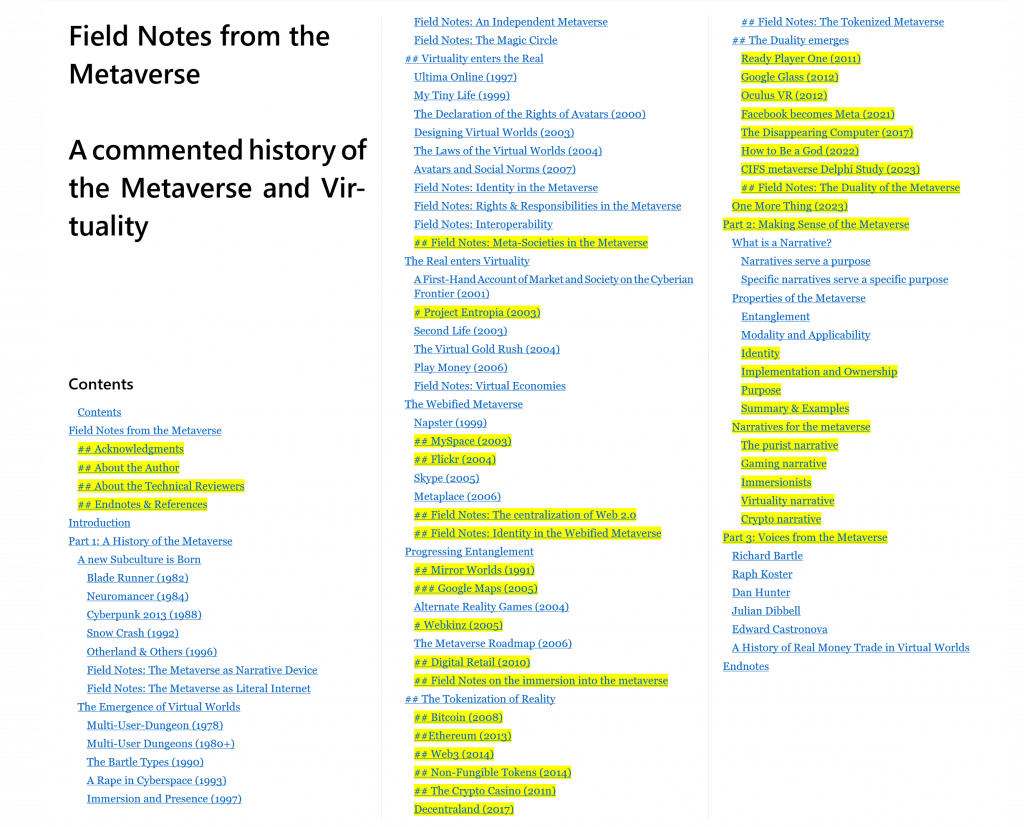This is a weekly update on my progress to document the history, perspectives, and narratives of the metaverse.
Current book word count: 73,582
Writing
A while ago I posted the sections and chapters of the book here: “Structuring my Field Notes.” This has changed quite a bit recently:

The main difference is that I broke out some chapters related to the World Wide Web and combined them into a new section called “The Webified Metaverse.” This section now leads nicely into field notes on why the Web eventually centralized, which then transitions into the mobile revolution and eventually into Web3.
Currently, the structure looks like this:
- A new subculture is born (1980 – 1986): Describing what led to the Cyberpunk genre, and how it spawned different visions for digital virtual worlds.
- The Emergence of Virtual Worlds (1978 – 1997): A look at the earliest virtual worlds, from MUD, to MUDs. It also describes how players realized that the experiences they had in these virtual worlds were not virtual at all.
- Virtuality enters the Real (1997 – 2007): How MUDs became MMORPGs, and the social, legal, and ethical implications of having millions of players in virtual worlds.
- The Real enters Virtuality (2001 – 2006): Diving into virtual economies and how they suddenly entangled themselves with the real economy. This includes trading virtual items for real money, the question of ownership and property, as well as business and tax considerations.
- The Webified Metaverse (1999 – 2006): Talking about how popular narratives of the metaverse shaped the World Wide Web, and how the implementation and the continuous evolution of the Web in turn re-shaped these narratives.
- Progressing Entanglement (2005 – 2010): The mobile revolution and how apps and Web 2.0 brought new concepts to accessing digital dimensions, but also how it started new societal trends in behaviour and expectations.
- The Tokenization of Reality (2008 – 2020): As Web 2.0 scaled into centralized entities, cryptocurrencies and blockchains were born out of libertarian efforts to de-centralize the Internet again, leading to Web3.
- The Duality emerges (2011 – 2023): The current understanding of the metaverse as a category term for “immersive life online,” including the tendency for performativity, and how new interest groups took over previous narratives for their own purposes.
If you look closely, you’ll notice that I have removed the dedicated chapter about virtual and augmented reality devices. These have been merged into the section “The Duality emerges.”
This also had an effect on the contextualization and field notes chapters, which have all been rewritten to fit the new structure.
I’m also thinking about posting some work-in-progress chapters to get your feedback.
Talking
The interview with Julian Dibbell is online! We talked about the intersection between real and virtual laws and its current limits. We also touched upon Web3 as a movement to regain some of the earlier optimism and semi-utopian visions that shaped the Web in the beginning.
The next interview on my desk is my recent discussion with Edward Castronova about virtual world economies and their relationships to reality. We started with his influential paper “Virtual Worlds: A First-Hand Account of Market and Society on the Cyberian Frontier” (2001) and how it was received academically and commercially. There are many personal stories and background information in this one and I can’t wait to publish it.
I’m also lining up another round of interviews, but nothing to report – yet 😁